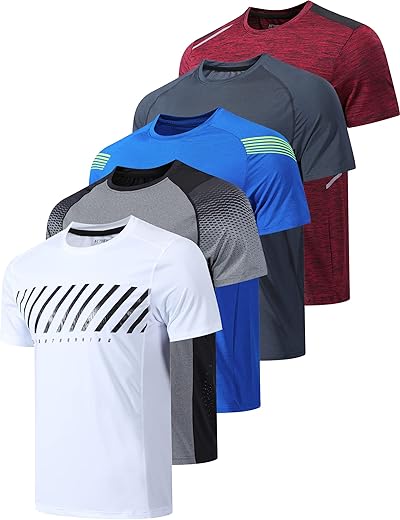Chưa phân loại
How to Transition Your Running Wardrobe from Summer to Fall
As the crisp air of fall creeps in, it’s time to refresh your running wardrobe to ensure you stay comfortable and motivated during your runs. This step-by-step guide empathetically walks you through the essential adjustments needed to transition from your lighter summer gear to autumn-appropriate attire. We’ll cover layering techniques, fabric choices, and accessories that will keep you warm and protected from unpredictable weather, all while helping you maintain the joy and passion you find in running. Embrace the changing seasons with a wardrobe that supports your performance and wellbeing.



Start by gathering all your summer running clothes and putting them in one place. Take a good look at each item and assess its condition. Check for signs of wear and tear, such as pilling, fading, or any damage like holes or frayed seams. Make note of what still fits well and provides the comfort you need for your runs.
Next, categorize your items based on their suitability for cooler temperatures. Separate lightweight tank tops and shorts from long-sleeve shirts, leggings, or heavier layers that can keep you warm. Identify any items that you think could be easily transitioned into your fall outfits, or that might still serve a purpose in cooler weather. Compile a list of items you need to replace or add to your wardrobe, such as thermal tops, thicker leggings, or moisture-wicking long-sleeve shirts.
Choose Layering Options
Choose lightweight, breathable base layers that can wick moisture away from your skin. Look for materials like merino wool or synthetic fabrics such as polyester and nylon that are designed to manage sweat and keep you dry. Opt for long-sleeve shirts and leggings that fit snugly to reduce bulk while providing core warmth. For example, a long-sleeve merino wool shirt paired with a high-performance polyester legging serves as an excellent foundation for your outfit, offering comfort and moisture control.
Layer these base pieces under jackets or vests for added warmth without compromising mobility. Select a versatile zip-up fleece jacket or an insulated vest that can be easily worn over your base layer. Whether you’re heading out into the chilly outdoors or just need an extra layer for cool evenings, these combinations will help regulate your temperature while keeping you comfortable. Remember to try on different pieces to ensure that you achieve a snug yet flexible fit that works for your layering needs.
Invest in Weather-Appropriate Outerwear
Select a good quality running jacket that offers both windproof and waterproof features. Look for options made from materials like Gore-Tex or similar technical fabrics that can withstand harsh weather conditions. Ensure the jacket has sealed seams and a water-repellent finish; these elements will provide additional protection against light rain and gusty winds. Brands like The North Face and Patagonia often have highly-rated running jackets that fit these criteria, ensuring you stay dry and comfortable during your runs.
Check for jackets equipped with ventilation options such as underarm zippers or mesh panels. This allows for increased airflow, helping you regulate your body temperature while running. Consider options like the Nike Shield jacket, which combines protection with breathability, or the Adidas Terrex jacket, known for its strategic ventilation designs. Pay attention to details like adjustable cuffs and hems, as these features help trap warmth while keeping out the wind and rain. Investing in quality ensures that your jacket performs well in various weather conditions, keeping you focused on your fitness goals.
Select the Right Footwear
Consider footwear that enhances traction and support in wet or slippery conditions. Look for shoes designed with aggressive tread patterns and rubber soles that grip surfaces effectively.
- Opt for trail running shoes if traversing uneven terrain. These shoes typically feature:
- A rugged outsole for superior grip.
- Extra cushioning for comfort over bumps and roots.
- A waterproof upper to keep your feet dry in damp conditions.
- Select shoes with a secure fit to prevent slipping inside the shoe. Adjustable laces or a snug heel can offer stability and prevent injuries.
- Try brands like Salomon, Merrell, or Hoka One One, known for their reliable trail running options, to find the right pair for your needs.
Remember, investing in quality footwear will enhance your safety and performance during outdoor activities.
Update Accessories
Incorporate fall-specific accessories into your running routine to enhance comfort and warmth. Add gloves to keep your hands cozy; choose lightweight, moisture-wicking options to prevent sweaty palms. Slip on headbands to cover your ears and manage sweat while keeping your hair in place. Opt for light hats to shield your face from the brisk wind and help maintain body heat on those cooler days.
Layer these accessories as needed for variable weather conditions. Experiment with different combinations to find what works best for you, ensuring you stay warm without overheating. Remember, having these items readily available can make your runs more enjoyable and help you stay focused on your pace and form.
Embrace Seasonal Change
In conclusion, transitioning your running wardrobe from summer to fall doesn’t have to be daunting. By taking the time to evaluate your existing gear, layering effectively, and choosing the right accessories, you’ll not only stay comfortable but also maintain your performance as the temperatures drop. Embrace the change in season by investing in quality outerwear and footwear that suit your needs, and don’t forget to test out your new gear before hitting the trails. With these simple steps, you’ll be ready to enjoy every mile, no matter the weather! Happy running!


Really helpful article! I always struggle with what to wear as the weather changes.
Love the idea of wool socks for those chilly runs! I might need to stock up.
OMG, I need to ditch my shorts for longer pants ASAP! Thanks for the reminder.
The part about reflective gear is so important. Safety first, people!
Great tips! I never thought about layering before. Can’t wait to try it!